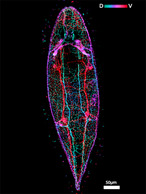- Record: found
- Abstract: found
- Article: found
The serotonergic nervous system of prolecithophorans shows a closer similarity to fecampiids than to triclads (Platyhelminthes)

Read this article at
Abstract
Prolecithophora is a poorly studied flatworm order belonging to the adiaphanidan clade, together with Tricladida and Fecampiida. The phylogenetic position of the three orders within this clade is not yet resolved. Additionally, no obvious synapomorphy other than an opaque epidermis could be found so far. In this study, the serotonergic nervous system of six different prolecithophoran species has been studied for the first time with a fluorescent immunocytochemical technique. We found that all six species show a similar pattern of the serotonergic nervous system. The typical prolecithophoran serotonergic nervous system consists of a cephalic ganglion in the anterior body part from which a pair of dorsal, ventral, and lateral longitudinal nerve cords originate. Furthermore, the three longitudinal nerve cords of one body side are connected to each other at the posterior body part by a conspicuous commissure. The ventral cords, which we consider the main cords, are most prominent and show double brain roots. A comparison of the nervous system within Adiaphanida shows clearly that prolecithophorans and fecampiids are much more similar in this regard than prolecithophorans and triclads.
Abstract
The nervous system in Prolecithophora has been studied for the first time using fluorescent immunocytochemistry. It consists of a brain and three longitudinal nerve cords, which are connected on either side of the body by the main lateral commissure. The ventral cords are considered as main cords and show two pairs of brain roots.
Related collections
Most cited references62
- Record: found
- Abstract: found
- Article: not found
Fiji: an open-source platform for biological-image analysis.

- Record: found
- Abstract: found
- Article: found
Invertebrate neurophylogeny: suggested terms and definitions for a neuroanatomical glossary

- Record: found
- Abstract: found
- Article: found
